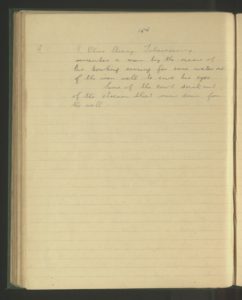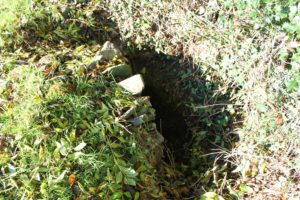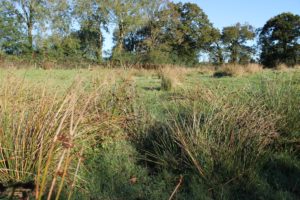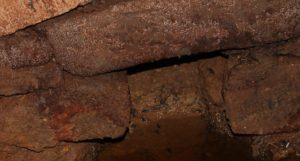Tobar an Iarainn
To the north-east of Ballyoughter, you will find the townland of Tubberneering (Toberanierin). Toberanierin is derived from the anglicisation of the Irish name for the area, ‘Tobar an Iarainn’ which translates as ‘The Iron Well’.
At Toberanierin Lower, you will find an historic Spa or Chalybeate Well. The location of the Chalybeate Well is shown on the map below. The word ‘chalybeate’ is an old English adjective meaning ‘ferruginous’ or ‘iron-rich’. The word was frequently used in the 1800s but has all but disappeared from the English language over the last two centuries.
Iron Wells were very popular in the 1700s and 1800s with their product, chalybeate water, advertised as a refreshing drink and for its medicinal healing qualities. One such promotional label on a water bottle from that era claimed ‘In regard to the Water itself, as a table beverage, it can be confidently recommended. Beautifully cool, clear, and effervescing, the taste clean, with just sufficient chalybeate astringency to remind one that there are healing virtues as well as simple refreshment in the liquid, this Mineral Water ought soon to become popular amongst all who can afford the very slight cost entailed’.
Toberanierin Spa is known to have had a celebrity visitor in the 1700s when Dean Jonathan Swift paid the well a visit to benefit from its healing capacity. Read more about this famous occasion at ‘The Past/Jonathan Swift’.
OSI Map showing the Chalybeate Well
Best viewed in full screen and using the ‘Zoom-in’ feature. The well is located in the top right quadrant and highlighted in yellow.
© Ordnance Survey Ireland/Government of Ireland. Copyright Permit No. MP 005821.
The Iron Well on 'The Schools Collection' on Dúchas.ie
Read the archival material on Tubberneering Well on Dúchas.ie – Pages 153 and 154.
The Iron Well Gallery
The Science of Iron Wells
The cause of Iron in well water results from the ease at which it is readily dissolved from practically all rocks and soils in the ground. The extent to which that happens depends on the type of rock and soil in the area.
In deep wells, when the oxygen content is low, the Iron water is clear and colourless because the Iron is dissolved. When exposed to air, the water will change from colourless (dissolved Iron particles) to coloured (undissolved Iron particles) because of the chemical process of oxidation. The Iron sediment first appears as yellow and, as the oxidation progresses, turns to a reddish-brown colour.
There are several problems associated with water that has high Iron content. The sediments that form on oxidation may block water pipes, may react with tannins in coffee, tea, and some alcoholic beverages to produce a black sludge which affects both taste and appearance. Iron water leads to a reddish-brown staining of laundry and kitchenware. These stains are very stubborn to remove, and the use of certain soaps/detergents may make matters worse.
Another problem is caused by naturally occurring non-disease-causing ‘Iron bacteria’ which occur in soil and aquifers. The bacteria ‘feed’ on Iron and form a reddish-brown slime where the water is above the well surface, such as at the opening of the well, in pipes, sinks, toilet bowls and cisterns.
Iron is an essential element in human nutrition and the human body controls and regulates the level of Iron in it. Drinking water with very high Iron levels upsets the body’s control of this mineral and can lead to gastro-intestinal problems such as constipation, nausea, diarrhoea, and vomiting. If you suffer from hereditary haemochromatosis (an inability of the body to regulate Iron absorption and distribution), it would be essential to measure the Iron levels in your well.







